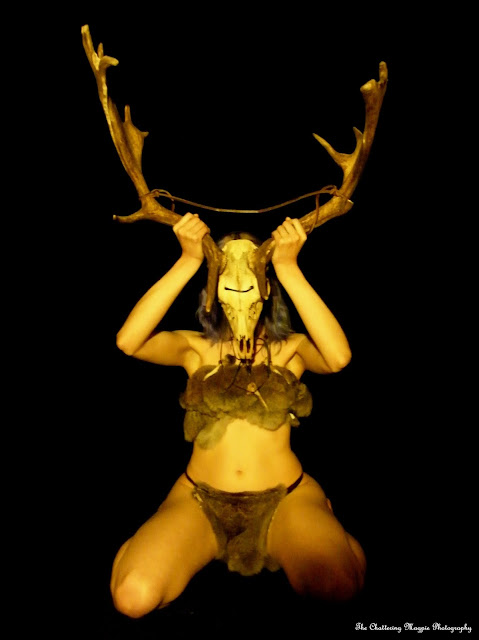The exhibition was an exploration of how Witches have been
perceived in various artistic mediums throughout history, with an obvious
emphasis upon the visual. The exhibition was not a presentation of how Witches
may have truly been or how they may have even perceived themselves. This was
the presentation of an artistic viewpoint, how Witches and their related
subjects, magic, sorcery, necromancy, are perceived by artists and presented in
art forms.
This was not a scientific, anthropological study of how
Witches truly were or even are. As such the exhibition presented an artistic
mirror, in which our society sees itself, its fears and how it perceives what
may confuse or puzzle. Those who visited the exhibition expecting to see accurate
depictions of Witchcraft, based upon folk practice and documentary sources, not
only misunderstood the concept of the exhibition but would have left sadly
disappointed.
The earliest works on display dated from the fifteenth century
and the latest from the nineteenth. This was a collection of almost half a millennia
of artistic interpretation of sorcery, placed together for comparison and
enjoyment. Yet no artwork of whatever medium, exists in a vacuum. Each works reflected
in some manner a social, cultural, political or theological influence.
The works on display included many world famous examples by
such renowned artists as Durer, Stuck, Goya, Delacroix, Rossetti, Burne-Jones
and Sandys. Indeed it was a remarkable surprise to see the Pre-Raphaelite
Brotherhood so well attested as an influence upon the subject, although the examples
on display were not what one would expect, being of a less romantic nature than
their usual output.
A presentation of this nature, with its distorted bodies and
twisted features, contrasting with those slightly more romantic depictions from
Shakespeare, raises questions about the nature of art. How do we define art and
can art really be defined at all, without placing limits upon it? What is the
function of art beyond the aesthetic? Not that the aesthetic quality of art is
in anyway unimportant, indeed one could argue that it is the vital element. Yet
beyond that, what is the function of art and should art always have a meaning?
Is it possible to produce art without a symbolist meaning? Is art descriptive,
challenging or purely a reflective model, trapped within the social and
cultural context of its time of origin?
Much of the exhibition unsurprisingly, concentrated upon the
female form, contrasting the loathsome; secret, black and midnight hags of
Shakespeare, with the more seductive Lilith archetype. Thrown into this
cauldron of metaphors was the occasional Medea but primarily the femininity
explored was of two extremes, the repulsiveness of great age with that of the
sexual allure of youth.
The exhibition reflected that social and traditional belief,
that women are more inclined towards sorcery than men. Few male practitioners
are named in our history and this is reflected in art. Figures such as Dee and
names from the Scottish trials such as Fian, stand out because they are so few
in number. Therefore the most notable other male named and included in this
exhibition was Faust, yet the most striking artistic reference to his famous
story was not of him but of Mephistopheles. Thus depicting as with the pictures
of the female sorcerers, the maleficent influence of the Devil, tempting man
and woman alike from the path of salvation.
To be able to stand, study and contemplate these wonders of
European art, some so famous in their familiarity that they feel like old
friends, was very special. I travelled to see the works of Durer and Goya. My
intent, to see the originals with my own eyes, rather than via some other medium,
a book or the Internet. It is therefore difficult to express my enjoyment and
pleasure, in not only seeing those works but the many other treasures gathered
for this important exhibition.
Almost five hundred years of European culture was explored,
comparing the more traditional, evil and loathsome imaginings of evil with the
later, more sceptical and sometimes humorous. The Devil himself travels from
the most repulsive, to become an almost dashing figure in the guise of a later Mephistopheles.
The figure of the female Witch, shown as equally repulsive in
the earlier works, likewise became increasing more attractive and less an
object of fear, as the beginning of the twentieth century approached. Yet even
if we accommodate this change in depiction, there remained a disturbing
paradox. Each and every image presented was almost without exception, a
negative one. From the hags of Durer and Goya, through Medea killing her
children, to Lady Macbeth and the company Witches, the allure still held an element
of danger, an undertone of malice and evil.
The scientific advancement of the nineteenth century and the
improved educational foundation of Victorian society, brought about a general scepticism
towards sorcery. Was that the victory of the Devil and of Witchcraft? Did
society embrace the Witch or simply cease to believe in magic?
The exhibition ‘Witches
and Wicked Bodies’ ran at the British Museum in London, from the 24th
of September 2014 to the 11th of January 2015.

























































